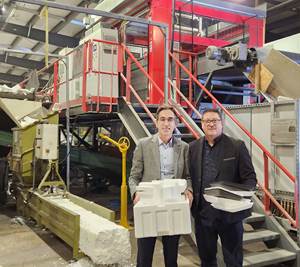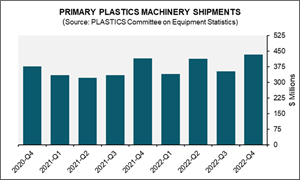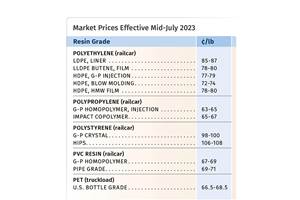Reusing Post-Consumer Plastics as a Concrete Strengthening Additive
Exposing discarded plastic to doses of gamma radiation changes the material’s crystalline structure in a way that makes the plastic stronger, stiffer and tougher.
MIT undergraduate students have found a way to make stronger concrete blocks using recycled plastic bottles. The students have found that by exposing plastic flakes to small, harmless doses of gamma radiation, then pulverizing the flakes into a fine powder, they can mix the irradiated plastic with cement paste and fly ash to produce concrete that is up to 15% stronger than conventional concrete, according to a news release from the university.
Concrete is the second most widely used material on the planet and its manufacture generates about 4.5% of the world’s human-induced carbon dioxide emissions.
This has the potential to pull plastic landfill waste out of the landfill and into buildings, where it could actually help to make them stronger.
“There is a huge amount of plastic that is landfilled every year,” says Michael Short, an assistant professor in MIT’s Department of Nuclear Science and Engineering. “Our technology takes plastic out of the landfill, locks it up in concrete, and also uses less cement to make the concrete, which makes fewer carbon dioxide emissions. This has the potential to pull plastic landfill waste out of the landfill and into buildings, where it could actually help to make them stronger.”
The team includes Carolyn Schaefer and MIT senior Michael Ortega, who initiated the research as a class project; Kunal Kupwade-Patil, a research scientist in the Department of Civil and Environmental Engineering; Anne White, an associate professor in the Department of Nuclear Science and Engineering; Oral Büyüköztürk, a professor in the Department of Civil and Environmental Engineering; Carmen Soriano of Argonne National Laboratory; and Short. The new paper appears in the journal Waste Management.
“This is a part of our dedicated effort in our laboratory for involving undergraduates in outstanding research experiences dealing with innovations in search of new, better concrete materials with a diverse class of additives of different chemistries,” says Büyüköztürk, who is the director of Laboratory for Infrastructure Science and Sustainability. “The findings from this undergraduate student project open a new arena in the search for solutions to sustainable infrastructure.”
Schaefer and Ortega began to explore the possibility of plastic-reinforced concrete as part of 22.033 (Nuclear Systems Design Project), in which students were asked to pick their own project.
The students learned that others have tried to introduce plastic into cement mixtures, but the plastic weakened the resulting concrete. Investigating further, they found evidence that exposing plastic to doses of gamma radiation makes the material’s crystalline structure change in a way that the plastic becomes stronger, stiffer and tougher.
So the students first obtained flakes of PET from a local recycling facility. Schaefer and Ortega manually sorted through the flakes to remove bits of metal and other debris. They then walked the plastic samples down to the basement of MIT’s Building 8, which houses a cobalt-60 irradiator that emits gamma rays, a radiation source that is typically used commercially to decontaminate food.
“There’s no residual radioactivity from this type of irradiation,” Short says. “If you stuck something in a reactor and irradiated it with neutrons, it would come out radioactive. But gamma rays are a different kind of radiation that, under most circumstances, leave no trace of radiation.”
The team exposed various batches of flakes to either a low or high dose of gamma rays. They then ground each batch of flakes into a powder and mixed the powders with a series of cement paste samples, each with traditional Portland cement powder and one of two common mineral additives: fly ash (a byproduct of coal combustion) and silica fume (a byproduct of silicon production). Each sample contained about 1.5% irradiated plastic.
Once the samples were mixed with water, the researchers poured the mixtures into cylindrical molds, allowed them to cure, removed the molds, and subjected the resulting concrete cylinders to compression tests. They measured the strength of each sample and compared it with similar samples made with regular, nonirradiated plastic, as well as with samples containing no plastic at all.
They found that, in general, samples with regular plastic were weaker than those without any plastic. The concrete with fly ash or silica fume was stronger than concrete made with just Portland cement. And the presence of irradiated plastic along with fly ash strengthened the concrete even further, increasing its strength by up to 15 percent compared with samples made just with Portland cement, particularly in samples with high-dose irradiated plastic.
After the compression tests, the researchers went one step further, using various imaging techniques to examine the samples for clues as to why irradiated plastic yielded stronger concrete.
The team took their samples to Argonne National Laboratory and the Center for Materials Science and Engineering (CMSE) at MIT, where they analyzed them using X-ray diffraction, backscattered electron microscopy, and X-ray microtomography. The high-resolution images revealed that samples containing irradiated plastic, particularly at high doses, exhibited crystalline structures with more cross-linking, or molecular connections. In these samples, the crystalline structure also seemed to block pores within concrete, making the samples more dense and therefore stronger.
Going forward, the team is planning to experiment with different types of plastics, along with various doses of gamma radiation, to determine their effects on concrete.
“At a nano-level, this irradiated plastic affects the crystallinity of concrete,” Kupwade-Patil says. “The irradiated plastic has some reactivity, and when it mixes with Portland cement and fly ash, all three together give the magic formula, and you get stronger concrete.”
“We have observed that within the parameters of our test program, the higher the irradiated dose, the higher the strength of concrete, so further research is needed to tailor the mixture and optimize the process with irradiation for the most effective results,” Kupwade-Patil says. “The method has the potential to achieve sustainable solutions with improved performance for both structural and nonstructural applications.”
Going forward, the team is planning to experiment with different types of plastics, along with various doses of gamma radiation, to determine their effects on concrete. For now, they have found that substituting about 1.5% of concrete with irradiated plastic can significantly improve its strength. While that may seem like a small fraction, Short says, implemented on a global scale, replacing even that amount of concrete could have a significant impact.
“Concrete produces about 4.5% of the world’s carbon dioxide emissions,” Short says. “Take out 1.5% of that, and you’re already talking about 0.0675% of the world’s carbon dioxide emissions. That’s a huge amount of greenhouse gases in one fell swoop.”
Related Content
Nexkemia Acquires Polystyrene Recycling Assets
The polystyrene manufacturer finalized its purchase of Eco-Captation, a recycler.
Read MorePlastics Machinery Shipments Rose in 2022’s Final Quarter
The Plastics Industry Association’s (PLASTICS) Committee on Equipment Statistics (CES) reported that injection molding and extrusion machinery shipments totaled $432.7 million in Q4.
Read MoreArtificial Intelligence Enables Smarter Sourcing
Westfall Technik has adopted Arkestro’s predictive procurement software to wring savings and more reliable deliveries from a historically challenging supply chain.
Read MorePS Prices Plunge, Others Appear to Be Bottoming Out
PS prices to see significant drop, with some potential for a modest downward path for others.
Read MoreRead Next
Lead the Conversation, Change the Conversation
Coverage of single-use plastics can be both misleading and demoralizing. Here are 10 tips for changing the perception of the plastics industry at your company and in your community.
Read MoreProcessor Turns to AI to Help Keep Machines Humming
At captive processor McConkey, a new generation of artificial intelligence models, highlighted by ChatGPT, is helping it wade through the shortage of skilled labor and keep its production lines churning out good parts.
Read MoreAdvanced Recycling: Beyond Pyrolysis
Consumer-product brand owners increasingly see advanced chemical recycling as a necessary complement to mechanical recycling if they are to meet ambitious goals for a circular economy in the next decade. Dozens of technology providers are developing new technologies to overcome the limitations of existing pyrolysis methods and to commercialize various alternative approaches to chemical recycling of plastics.
Read More















.png;maxWidth=300;quality=90)














